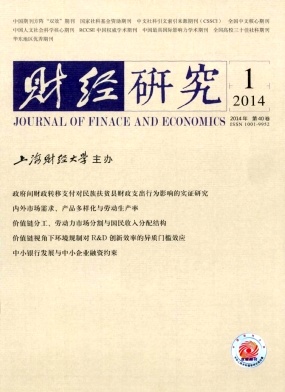内外市场需求、产品多样化与劳动生产率——基于中国城市面板数据的实证分析
财经研究 2014 年 第 40 卷第 01 期, 页码:27 - 41
摘要
参考文献
摘要
文章在新经济地理框架下构建理论、计量模型及内外市场需求测度,运用2003-2011年284个地级及以上城市面板数据检验了国内、国际市场潜力和产品多样化对城市劳动生产率的影响。结果表明,我国各城市间整体上互为商品市场,存在显著的需求关联效应;国内、国际市场需求和产品多样化均显著促进了城市劳动生产率的提高,且国内市场潜力加强了产品多样化的影响效果。国际市场潜力对城市劳动生产率的贡献率明显低于国内市场潜力。各地区国内市场潜力、产品多样化及其交叉项系数均显著为正,且由东向西依次递减;国际市场潜力显著提高了东、西部劳动生产率,但不利于中部劳动生产率的提高;国内、国际市场对劳动生产率的影响作用在东、西部存在互补性,而在中部地区具有替代性。
[1]韩峰,柯善咨.追踪我国制造业集聚的空间来源:基于马歇尔外部性与新经济地理的综合视角[J].管理世界,2012,(10):55-70.
[2]顾朝林,庞海峰.基于重力模型的中国城市体系空间联系与层域划分[J].地理研究,2008,(1):1-12.
[3]刘修岩,殷醒民,贺小海.市场潜能与制造业空间集聚:基于中国地级城市面板数据的经验研究[J].世界经济,2007,(11):56-63.
[4]刘修岩,殷醒民.空间外部性与地区工资差异:基于动态面板数据的实证研究[J].经济学(季刊),2009,(1):77-98.
[5]刘修岩,张学良.集聚经济与企业区位选择——基于中国地级区域企业数据的实证研究[J].财经研究,2010,(11):83-92.
[6]潘文卿.中国的区域关联与经济增长的空间溢出效应[J].经济研究,2012,(1):54-65.
[7]赵永亮.中国内外需求的市场潜力研究——基于工资方程的边界效应分析[J].管理世界,2011,(1):20-29.
[8]祝树金,戟璇,傅晓岚.出口品技术水平的决定性因素:来自跨国面板数据的证据[J].世界经济,2010,(4):28-46.
[9]Au C,Henderson V.Estimating net urban agglomeration economies:With an application to China[R].Working Paper,Brown University,2004.
[10]Ciccone A,Hall R.Productivity,and the density of economic activity[J].American Economic Review,1996,86(1):54-70.
[11]Ciccone A.Agglomeration effects in Europe[J].European Economic Review,2002,46(2):213-227.
[12]Clemente J,Pueyo F,Sanz F.Market potential,European Union and growth[J].Journal of Policy Modeling,2009,31(5):719-730.
[13]Combes P P,Magnac T,Robin J M.The dynamics of local employment in France[R].CEPR Discussion Paper,No.3912,2002.
[14]Combes P P,Overman H.The spatial distribution of economic activities in the European Union[A].Henderson V,Thisse J F(eds.).Handbook of regional and urban economics[C].Amsterdam:North Holland,2004.
[15]Dixit A K,Stiglitz J E.Monopolistic competition and optimum product diversity[J].The American Economic Review,1977,67(3):297-308.
[16]Fujita M,Krugman P.When is the economy monocentric?:von Thunen and chamberlin unified[J].Regional Science and Urban Economics,1995,25(4):505-528.
[17]Harris C D.The market as a factor in the localization of industry in the United States[J].Annals of the Association of American Geographers,1954,44(4):315-348.
[18]Hanson G H.Market potential,increasing returns and geographic concentration[J].Journal of International Economics,2005,67(1):1-24.
[19]Head K,Mayer T.Market potential and the location of Japanese investment in the European Union[J].The Review of Economics and Statistics,2004,86(4):959-972.
[20]Head K,Mayer T.Regional wage and employment response to market potential in the EU[J].Regional Science and Urban Economics,2006,36(5):573-594.
[21]Helpman E.The size of regions[A].Pines D,Sadka E,Zilcha I(eds.).Topics in public economics:Theoretical and applied analysis[C].Cambridge:Cambridge University Press,1998.
[22]Keeble D,Owens P L,Thompson C.Regional accessibility and economic potential in the European community[J].Regional Studies,1982,16(6):419-432.
[23]Krugman P.Scale economies,product differentiation,and the pattern of trade[J].The American Economic Review,1980,70(5):950-959.
[24]Krugman P.Increasing returns and economic geography[J].Journal of Political Economy,1991,99(3):483-499.
[25]Krugman P.A dynamic spatial model[R].NBER,Working Paper,No.4219,1992.
[26]Krugman P,Venables A.Globalization and the inequality of nations[J].Quarterly Journal of Economics,1995,110(4):857-880.
[27]Linneker B J,Spence N A.An accessibility analysis of the impact of the M25London Orbital Motorway on Britain[J].Regional Studies,1992,26(1):31-47.
[28]Midelfart-Knarvik K H,Overman H G,Venables A J.Comparative advantage and economic geography:Estimating the location of production in the EU[R].CEPR Discussion Paper,No.2618,2000.
[29]Ottaviano G I P,Pinelli D.Market potential and productivity:Evidence from finnish regions[J].Regional Science and Urban Economics,2006,36(5):636-657.
[30]Overman H G,Redding S,Venables A J.The economic geography of trade,production,and income:A survey of empirics[A].Choi E K,Harrigan J(eds).Handbook of international trade[C].US:Blackwell Publishing Ltd.,2003.
[31]Puga D.The rise and fall of regional inequalities[J].European Economic Review,1999,43(2):303-334.
[32]Roodman D.How to do xtabond2:An introduction to difference and system GMM in stata[R].Center for Global Development Working Paper No.103,2006.
[33]Stewart J Q.Empirical mathematical rules concerning the distribution and equilibrium of population[J].Geographical Review,1947,37(3):461-485.
[34]Venables A J.Equilibrium locations of vertically linked industries[J].International Economic Review,1996,37(2):341-359.
[35]Zheng X P.Determinants of agglomeration economies and diseconomies:Empirical evidence from Tokyo[J].Socio-Economic Planning Sciences,2001,35(2):131-144.
①此处的市场需求特指最终商品需求,而不包含对中间投入品的需求。
②ci为边际成本,而不是众多新经济地理模型中的边际劳动需求。
③中国土地市场实际上是供给方垄断市场,在给定一定供给量的情况下,或城市土地利用规划形成后的一段时间内,土地供应量一般变化不大,因而现实中城市土地供给可能并非完全是土地价格的函数。土地价格主要受土地使用者或需求方(如厂商和住户等)的影响。
④根据新经济地理理论,一般认为某地区制造业产品多样化水平越高,则其CES价格指数越小,制造业集聚规模就越大,从而越有利于中间投入品生产实现规模经济效益,中间服务品价格也就越低。因此,制造品CES价格指数与中间品价格正相关,二者均与产品多样化水平负相关。
⑤由于城市中工业用地和住宅用地均属国有土地,其收益归政府所有,因而本文模型中个人收益仅指其获得的工资收益。
⑥我国的主要沿海港口城市有丹东、大连、营口、锦州、秦皇岛、唐山、天津、烟台、威海、青岛、连云港、镇江、南京、上海、宁波、福州、厦门、汕头、广州、中山、深圳、珠海、湛江、海口和三亚,主要陆路港口城市有凭祥、东兴、喀什、阿拉山口、漠河和满洲里。
⑦限于篇幅,本文未列出衰减参数为2时的系统GMM估计结果,有兴趣的读者可来函索取。
⑧即使市场潜力对劳均非农业GDP的“量”产生促进作用,但未必对其增长率有影响。
⑨我们估算了全国284个地级及以上城市国内市场潜力和国际市场潜力的贡献率,限于篇幅,本文仅列出了各省会城市的计算结果,但这不会影响其整体的空间分布和变化趋势。有兴趣的读者可来函索取全部测算结果。
考虑到东北地区数据量小,我们把比较发达的辽宁并入东部地区、吉林和黑龙江并入中部地区,因而东部地区包括北京、福建、广东、海南、河北、江苏、辽宁、山东、上海、天津和浙江11个省市,中部地区包括安徽、河南、黑龙江、湖北、湖南、吉林、江西和山西8个省份,西部地区包括广西、贵州、内蒙古、宁夏、青海、陕西、甘肃、四川、新疆、云南和重庆11个省市。
[2]顾朝林,庞海峰.基于重力模型的中国城市体系空间联系与层域划分[J].地理研究,2008,(1):1-12.
[3]刘修岩,殷醒民,贺小海.市场潜能与制造业空间集聚:基于中国地级城市面板数据的经验研究[J].世界经济,2007,(11):56-63.
[4]刘修岩,殷醒民.空间外部性与地区工资差异:基于动态面板数据的实证研究[J].经济学(季刊),2009,(1):77-98.
[5]刘修岩,张学良.集聚经济与企业区位选择——基于中国地级区域企业数据的实证研究[J].财经研究,2010,(11):83-92.
[6]潘文卿.中国的区域关联与经济增长的空间溢出效应[J].经济研究,2012,(1):54-65.
[7]赵永亮.中国内外需求的市场潜力研究——基于工资方程的边界效应分析[J].管理世界,2011,(1):20-29.
[8]祝树金,戟璇,傅晓岚.出口品技术水平的决定性因素:来自跨国面板数据的证据[J].世界经济,2010,(4):28-46.
[9]Au C,Henderson V.Estimating net urban agglomeration economies:With an application to China[R].Working Paper,Brown University,2004.
[10]Ciccone A,Hall R.Productivity,and the density of economic activity[J].American Economic Review,1996,86(1):54-70.
[11]Ciccone A.Agglomeration effects in Europe[J].European Economic Review,2002,46(2):213-227.
[12]Clemente J,Pueyo F,Sanz F.Market potential,European Union and growth[J].Journal of Policy Modeling,2009,31(5):719-730.
[13]Combes P P,Magnac T,Robin J M.The dynamics of local employment in France[R].CEPR Discussion Paper,No.3912,2002.
[14]Combes P P,Overman H.The spatial distribution of economic activities in the European Union[A].Henderson V,Thisse J F(eds.).Handbook of regional and urban economics[C].Amsterdam:North Holland,2004.
[15]Dixit A K,Stiglitz J E.Monopolistic competition and optimum product diversity[J].The American Economic Review,1977,67(3):297-308.
[16]Fujita M,Krugman P.When is the economy monocentric?:von Thunen and chamberlin unified[J].Regional Science and Urban Economics,1995,25(4):505-528.
[17]Harris C D.The market as a factor in the localization of industry in the United States[J].Annals of the Association of American Geographers,1954,44(4):315-348.
[18]Hanson G H.Market potential,increasing returns and geographic concentration[J].Journal of International Economics,2005,67(1):1-24.
[19]Head K,Mayer T.Market potential and the location of Japanese investment in the European Union[J].The Review of Economics and Statistics,2004,86(4):959-972.
[20]Head K,Mayer T.Regional wage and employment response to market potential in the EU[J].Regional Science and Urban Economics,2006,36(5):573-594.
[21]Helpman E.The size of regions[A].Pines D,Sadka E,Zilcha I(eds.).Topics in public economics:Theoretical and applied analysis[C].Cambridge:Cambridge University Press,1998.
[22]Keeble D,Owens P L,Thompson C.Regional accessibility and economic potential in the European community[J].Regional Studies,1982,16(6):419-432.
[23]Krugman P.Scale economies,product differentiation,and the pattern of trade[J].The American Economic Review,1980,70(5):950-959.
[24]Krugman P.Increasing returns and economic geography[J].Journal of Political Economy,1991,99(3):483-499.
[25]Krugman P.A dynamic spatial model[R].NBER,Working Paper,No.4219,1992.
[26]Krugman P,Venables A.Globalization and the inequality of nations[J].Quarterly Journal of Economics,1995,110(4):857-880.
[27]Linneker B J,Spence N A.An accessibility analysis of the impact of the M25London Orbital Motorway on Britain[J].Regional Studies,1992,26(1):31-47.
[28]Midelfart-Knarvik K H,Overman H G,Venables A J.Comparative advantage and economic geography:Estimating the location of production in the EU[R].CEPR Discussion Paper,No.2618,2000.
[29]Ottaviano G I P,Pinelli D.Market potential and productivity:Evidence from finnish regions[J].Regional Science and Urban Economics,2006,36(5):636-657.
[30]Overman H G,Redding S,Venables A J.The economic geography of trade,production,and income:A survey of empirics[A].Choi E K,Harrigan J(eds).Handbook of international trade[C].US:Blackwell Publishing Ltd.,2003.
[31]Puga D.The rise and fall of regional inequalities[J].European Economic Review,1999,43(2):303-334.
[32]Roodman D.How to do xtabond2:An introduction to difference and system GMM in stata[R].Center for Global Development Working Paper No.103,2006.
[33]Stewart J Q.Empirical mathematical rules concerning the distribution and equilibrium of population[J].Geographical Review,1947,37(3):461-485.
[34]Venables A J.Equilibrium locations of vertically linked industries[J].International Economic Review,1996,37(2):341-359.
[35]Zheng X P.Determinants of agglomeration economies and diseconomies:Empirical evidence from Tokyo[J].Socio-Economic Planning Sciences,2001,35(2):131-144.
①此处的市场需求特指最终商品需求,而不包含对中间投入品的需求。
②ci为边际成本,而不是众多新经济地理模型中的边际劳动需求。
③中国土地市场实际上是供给方垄断市场,在给定一定供给量的情况下,或城市土地利用规划形成后的一段时间内,土地供应量一般变化不大,因而现实中城市土地供给可能并非完全是土地价格的函数。土地价格主要受土地使用者或需求方(如厂商和住户等)的影响。
④根据新经济地理理论,一般认为某地区制造业产品多样化水平越高,则其CES价格指数越小,制造业集聚规模就越大,从而越有利于中间投入品生产实现规模经济效益,中间服务品价格也就越低。因此,制造品CES价格指数与中间品价格正相关,二者均与产品多样化水平负相关。
⑤由于城市中工业用地和住宅用地均属国有土地,其收益归政府所有,因而本文模型中个人收益仅指其获得的工资收益。
⑥我国的主要沿海港口城市有丹东、大连、营口、锦州、秦皇岛、唐山、天津、烟台、威海、青岛、连云港、镇江、南京、上海、宁波、福州、厦门、汕头、广州、中山、深圳、珠海、湛江、海口和三亚,主要陆路港口城市有凭祥、东兴、喀什、阿拉山口、漠河和满洲里。
⑦限于篇幅,本文未列出衰减参数为2时的系统GMM估计结果,有兴趣的读者可来函索取。
⑧即使市场潜力对劳均非农业GDP的“量”产生促进作用,但未必对其增长率有影响。
⑨我们估算了全国284个地级及以上城市国内市场潜力和国际市场潜力的贡献率,限于篇幅,本文仅列出了各省会城市的计算结果,但这不会影响其整体的空间分布和变化趋势。有兴趣的读者可来函索取全部测算结果。
考虑到东北地区数据量小,我们把比较发达的辽宁并入东部地区、吉林和黑龙江并入中部地区,因而东部地区包括北京、福建、广东、海南、河北、江苏、辽宁、山东、上海、天津和浙江11个省市,中部地区包括安徽、河南、黑龙江、湖北、湖南、吉林、江西和山西8个省份,西部地区包括广西、贵州、内蒙古、宁夏、青海、陕西、甘肃、四川、新疆、云南和重庆11个省市。
引用本文
韩峰, 阳立高. 内外市场需求、产品多样化与劳动生产率——基于中国城市面板数据的实证分析[J]. 财经研究, 2014, 40(1): 27–41.
导出参考文献,格式为:





 7374
7374  4813
4813

